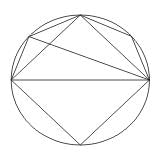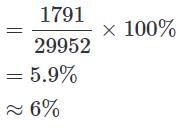ECGC PO Mock Test - 9 - Bank Exams MCQ
30 Questions MCQ Test - ECGC PO Mock Test - 9
There are six people A, B, C, D, E and F each having different weight. A is heavier than F but lighter than B. E is heavier than C but lighter than A. B is higher than D. C is not the lighest. The second lighest person weight 52kg while the third lighest is of 64kg.
Q.
How many persons are heavier than C?
How many persons are heavier than C?
Directions to Solve
In each of the following questions find out the alternative which will replace the question mark.
Question -
Flow : River :: Stagnant : ?
Directions to Solve: In each of the questions below consists of a question and two statements numbered I and II given below it. You have to decide whether the data provided in the statements are sufficient to answer the question. Read both the statements and
Give answer:
- (A) If the data in statement I alone are sufficient to answer the question, while the data in statement II alone are not sufficient to answer the question
- (B) If the data in statement II alone are sufficient to answer the question, while the data in statement I alone are not sufficient to answer the question
- (C) If the data either in statement I alone or in statement II alone are sufficient to answer the question
- (D) If the data given in both statements I and II together are not sufficient to answer the question and
- (E) If the data in both statements I and II together are necessary to answer the question.
Question: On which date of the month was Anjali born in February 2004 ?
Statements:
I.Anjali was born on an even date of the month.
II.Anjali's birth date was a prime number.
- (A) If the data in statement I alone are sufficient to answer the question, while the data in statement II alone are not sufficient to answer the question
- (B) If the data in statement II alone are sufficient to answer the question, while the data in statement I alone are not sufficient to answer the question
- (C) If the data either in statement I alone or in statement II alone are sufficient to answer the question
- (D) If the data given in both statements I and II together are not sufficient to answer the question and
- (E) If the data in both statements I and II together are necessary to answer the question.
Statements:
I.Anjali was born on an even date of the month.
II.Anjali's birth date was a prime number.
Directions: This question given below is followed by two arguments numbered I and II. You have to decide which of the following arguments is a ‘strong’ argument and which is a ‘weak’ argument.
Statement:
Should cricket be included in the Olympics?
Arguments:
I. Yes. It is hugely popular in countries like India and England.
II. No. On the whole, only a handful of countries have prominent cricket teams, whereas Olympics require participation from most of the countries of the World.
Directions: This question given below is followed by two arguments numbered I and II. You have to decide which of the following arguments is a ‘strong’ argument and which is a ‘weak’ argument.
Statement:
Should ‘Personal Finance’ be taught in schools?
Arguments:
I. Yes. It will equip the school students with knowledge about investing, savings etc and help them in making informed decisions when they’re earning.
II. No. School students should be kept away from money matters as it can have a negative impact on them.
Directions: Study the following information carefully and answer the question given below it.
A word and number arrangement machine, when given an input line of words and numbers, rearranges them following a particular rule in each step. The following is an illustration of an input and the rearrangement:
Input: past back 32 47 19 own fear 25
Step I: 19 past back 32 47 own fear 25
Step II: 19 past 25 back 32 47 own fear
Step III: 19 past 25 own back 32 47 fear
Step IV: 19 past 25 own 32 back 47 fear
Step V: 19 past 25 own 32 fear back 47
Step VI: 19 past 25 own 32 fear 47 back
Step VI is the last step.
As per the rules followed in the above steps, find out the appropriate step for the given input.
Input: case over 12 36 49 long ago 42
Q. Which of the following steps will be the second-last?
If the sum and product of the roots of the equation kx2 + 6x + 4k = 0 are equal, then k =
A Special pump can be used for filling as well as for emptying a Cistern. The capacity of the Cistern is 2400m³. The emptying capacity of the Cistern is 10m³ per minute higher than its filling capacity and the pump needs 8 minutes lesser to Cistern the tank than it needs to fill it. What is the filling capacity of the pump?
The ratio of income of Aman to income of Raman is 4 : 3. Their expenditures are in the ratio 3 : 1. If their respective savings are Rs. 16,000 and Rs. 25,000, what is the income of Aman?
The outer circumference of a circular track is 220 meter. The track is 7 meter wide everywhere. Calculate the cost of levelling the track at the rate of 50 paise per square meter.
A pit 7.5 meter long, 6 meter wide and 1.5 meter deep is dug in a field. Find the volume of soil removed in cubic meters.
Directions: Study the following information carefully and answer the questions given beside.
Two trains A and B running at speeds 42 km/hr and 48 km/hr respectively are approaching each other. They are [A] km far from each other. After 12 minutes, a vulture starts flying from train A towards train B at the speed of [B] km/hr. It reverses its direction as soon as it reached B and starts filying towards A and continues this until trains A and B meet. The total distance covered by it is [C] km. The vulture meets train B (first time) in half the time train A meets train B (from the time vulture started). The distance between the points where train B meets vulture for the first time and train B meets train A is 72 km. The distance between trains A and B, when the vulture meets train B for the second time is [D].
Q. What will come in place of B?
Directions: The following pie-chart shows the sources of funds to be collected by the National Highways Authority of India (NHAI) for its phase II projects. Study the pie-chart and answer the following three questions:
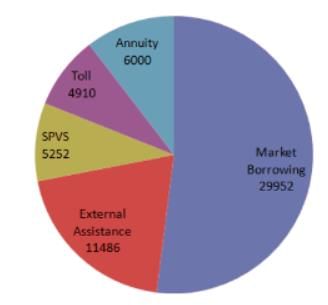
Q. If NHAI could receive a total of Rs. 9,695 crores as External Assistance, by what percent (approximately) should it increase the market Borrowing to arrange for the shortage of funds?
Directions: Study the pie-chart and table given below and answer the questions.
Details of the percentage of employees working in various departments in an organization and number of males among them.
Total number of employees = 800.
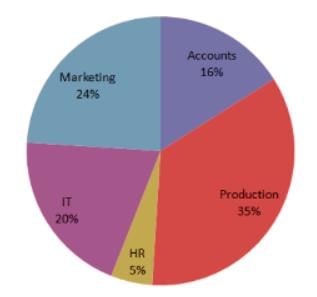
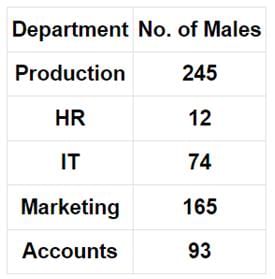
Q. The percentage of the number of male employees working in marketing department to the total number of employees in marketing department is:
Directions: Study the pie-chart and table given below and answer the questions.
Details of the percentage of employees working in various departments in an organization and number of males among them.
Total number of employees = 800.
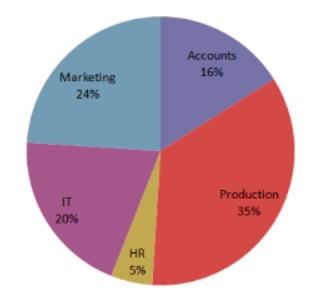
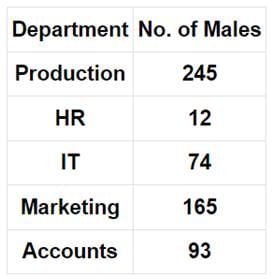
Q. The ratio of number of males in marketing department to the number of females working in that department is:
The brand proposition now, therefore, had to be that Keokarpin Antiseptic Cream is more effective / because it penetrates deep down (being light and non-sticky) and works from within / (because of its ayurvedic ingredients) to keep skin blemish, free, and helps cope with cuts nicks, burns, and nappy rash. / No error.
Most of the members at the meeting felt / hat the group appointed for investigating the case / were not competent to do the job efficiently / No error.
Although coffee is not usually considered a drug, it is so addictive that it hasbecome a critical part of breakfast for many people.
Direction: Read the following passage carefully and answer the question that follows.
After a worrying pre-monsoon phase between March and May, when rainfall was scarce, the current robust season in most parts of coastal, western and central India augurs well for the entire economy. Aided apparently by beneficial conditions in the Indian Ocean, very heavy rainfall has been recorded, notably in Maharashtra, Gujarat, Rajasthan, the northeastern States, Karnataka, the Konkan coast, hilly districts of Kerala and Tamil Nadu. This pattern may extend into Chhattisgarh, Odisha, Bengal and other eastern regions. A normal Indian Summer Monsoon is bountiful overall, but as last year’s flooding in Kerala, and the Chennai catastrophe of 2015 showed, there can be a terrible cost in terms of lives and property lost, and people displaced. Distressing scenes of death and destruction are again being witnessed. Even in a rain-shadow region such as Coimbatore in Tamil Nadu, the collapse of a railway parcel office after a downpour has led to avoidable deaths. What this underscores is the need to prepare for the rainy season with harvesting measures, as advocated by the Centre’s Jal Shakti Abhiyan, and a safety audit of structures, particularly those used by the official agencies. In drafting their management plans, States must be aware of the scientific consensus: that future rain spells may be short, often unpredictable and very heavy influenced by a changing climate. They need to invest in reliable infrastructure to mitigate the impact of flooding and avert disasters that could have global consequences in an integrated economy.
The long-term trends for flood impact in India have been one of declining loss of lives and cattle since the decadal high of 1971-80, but rising absolute economic losses, though not as a share of GDP. It is important, therefore, to increase resilience through planning, especially in cities and towns which are expanding steadily. Orderly urban development is critical for sustainability, as the mega flood disasters in Mumbai and Chennai witnessed in this century make clear. It is worth pointing out that the response of State governments to the imperative is tardy and even indifferent. They are hesitant to act against encroachment of lake catchments, river courses and floodplains. The extreme distress in Chennai, for instance, has not persuaded the State government against allowing structures such as a police station being constructed on a lake bed, after reclassification of land. Granting such permissions is an abdication of responsibility and a violation of National Disaster Management Authority Guidelines to prevent urban flooding. As a nation that is set to become the most populous in less than a decade, India must address its crippling cycles of drought and flood with redoubled vigour. Scientific hydrology, coupled with the traditional wisdom of saving water through large innovative structures, will mitigate floods and help communities prosper.
Q. Which among the following gives us the correct picture of monsoon in the current year as stated in the passage?
Direction: Read the following passage carefully and answer the question that follows.
After a worrying pre-monsoon phase between March and May, when rainfall was scarce, the current robust season in most parts of coastal, western and central India augurs well for the entire economy. Aided apparently by beneficial conditions in the Indian Ocean, very heavy rainfall has been recorded, notably in Maharashtra, Gujarat, Rajasthan, the northeastern States, Karnataka, the Konkan coast, hilly districts of Kerala and Tamil Nadu. This pattern may extend into Chhattisgarh, Odisha, Bengal and other eastern regions. A normal Indian Summer Monsoon is bountiful overall, but as last year’s flooding in Kerala, and the Chennai catastrophe of 2015 showed, there can be a terrible cost in terms of lives and property lost, and people displaced. Distressing scenes of death and destruction are again being witnessed. Even in a rain-shadow region such as Coimbatore in Tamil Nadu, the collapse of a railway parcel office after a downpour has led to avoidable deaths. What this underscores is the need to prepare for the rainy season with harvesting measures, as advocated by the Centre’s Jal Shakti Abhiyan, and a safety audit of structures, particularly those used by the official agencies. In drafting their management plans, States must be aware of the scientific consensus: that future rain spells may be short, often unpredictable and very heavy influenced by a changing climate. They need to invest in reliable infrastructure to mitigate the impact of flooding and avert disasters that could have global consequences in an integrated economy.
The long-term trends for flood impact in India have been one of declining loss of lives and cattle since the decadal high of 1971-80, but rising absolute economic losses, though not as a share of GDP. It is important, therefore, to increase resilience through planning, especially in cities and towns which are expanding steadily. Orderly urban development is critical for sustainability, as the mega flood disasters in Mumbai and Chennai witnessed in this century make clear. It is worth pointing out that the response of State governments to the imperative is tardy and even indifferent. They are hesitant to act against encroachment of lake catchments, river courses and floodplains. The extreme distress in Chennai, for instance, has not persuaded the State government against allowing structures such as a police station being constructed on a lake bed, after reclassification of land. Granting such permissions is an abdication of responsibility and a violation of National Disaster Management Authority Guidelines to prevent urban flooding. As a nation that is set to become the most populous in less than a decade, India must address its crippling cycles of drought and flood with redoubled vigour. Scientific hydrology, coupled with the traditional wisdom of saving water through large innovative structures, will mitigate floods and help communities prosper.
Q. Which among the following is correct regarding the pattern of rainfall in the future as declared by the scientific community?
Directions: Out of the given alternatives, choose the one which can be substituted for the given words/sentence.
A person who is indifferent to pains and pleasure of life:
A semiconductor wafer on which thousands or millions of tiny resistors, capacitors, and transistors are manufactured is known as an integrated circuit (IC). Which element is used to make computer chips and IC?
Which device converts human-understandable data and programs into a form that computers can understand and process?
Which of the following is the function of a database management system (DBMS)?
A feature of MS Word that saves the document automatically after certain intervals is available in
________ are upgrades to the software and operating systems (OS) that fix security flaws in a program or product.
Which organization received the GeM award in the "Timely Payments (CPSEs)" category?
What is the significance of the 67th TAAI Convention in the travel industry?
What major financial challenge does the India AI Mission face?



